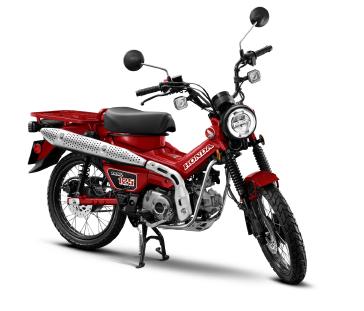In 1960, the efforts of a Honda motorcycle dealer in Boise, Idaho, came to the attention of Jack McCormack, the sales manager at the 1-year old American Honda Motor Co. As told by Aaron P. Frank in his book, Honda Motorcycles, McCormack had noticed the sales of the popular step-through Honda 50 were off the charts in an area known more for its surrounding rugged mountain terrain than an urban core. He contacted the owner, Herb Uhl, seeking an explanation.
“He told me how he was selling them as a trail bike, putting a cheater sprocket on the back and some knobby tires,” McCormack told Frank. Uhl sent one of his converted Honda 50s down to California for McCormack to inspect.
“It was a brilliant little machine,” McCormack said. “It worked so well because it was light, and with the automatic clutch you could climb logs. To do that on a big bike, you had to have a certain amount of skill. I saw lots of possibility for something like Herb was doing, selling it as a bike that you could go in the woods and hunt or fish with.”
McCormack sent the bike to American Honda’s parent company in Japan, with a request to build a production version of Uhl’s off-road adaptation. By March 1961, the CA100T Trail 50 was offered to Honda dealers across America.
Honda’s first foray into off-road motorcycling was an immediate success, hailed by Cycle World magazine with the recommendation that readers go “Trail Fiftying.” The model evolved through numerous upgrades and revisions, eventually becoming the popular CT brand. Over the course of nearly three decades, well over 725,000 units from the CT series were sold in the U.S.
1961 CA100T Trail 50
The first Uhl-inspired production Trail 50 transmitted its 49cc overhead-valve engine’s 5 horsepower through a three-speed semiautomatic transmission. Knobby tires were mounted on full-size, 17-inch wheels, and the original Honda 50’s leg shield and front fender were removed for better off-road utility. The front suspension retained the Honda 50’s then-modern, leading-link design. A double rear sprocket permitted changes to the overall gearing, a nod to the Trail 50’s off-road suitability. A single saddle was positioned ahead of a large chrome utility rack, which could be replaced by an optional passenger seat. A skid plate was provided to protect the low-slung engine. The street-legal headlight and taillight enhanced the bike’s dual-sport capabilities. The retail price was $275.
The model evolved over the next couple of years, getting updates like a 5cc larger engine, a thicker seat and an upswept muffler, and it soon earned the nickname “Hunter Cub” in some markets.
1964 CT200 Trail 90
In 1964, the CT200 Trail 90 was introduced, powered by a larger, air-cooled 87cc engine and a new four-speed semi-automatic transmission with a centrifugal clutch. It included a purposeful front fender with mudguard, and the high-mounted intake and exhaust protected the engine from ingesting water in stream crossings.
Two years later the name was changed to the CT90 Trail 90, with numerous upgrades. An all-new 89cc engine with a lightweight, aluminum-alloy head used a reliable chain-driven, overhead camshaft. The dual-rear-sprocket arrangement was replaced by a selectable reduction gear in the transmission, a feature Honda called “Posi-Torque” that effectively gave the CT90 an eight-speed gearbox—ideal for crawling over all types of terrain—with the flip of a lever on the transmission case. Dry weight was a feathery 179 pounds, and it was claimed to produce 7 horsepower at 8,500 rpm.
A compliant, telescopic fork was introduced in 1969, and one year later a foldable, swivel-lock handlebar was added, simplifying transport in a van, pickup or trailer. Turn signals were added in 1974, making the Trail 90 completely legal for street riding in all 50 states whenever desired.
CT70 Trail 70
Concurrent with the evolution of the larger CT models, the minibike-based CT70 Trail 70 was introduced in 1969 and was sold in the U.S. until 1982, then reintroduced in 1991 and carried over the next three years. The fun-to-ride Trail 70 was a prototypical play bike that took many of its styling cues from the popular Z50 dirt bike as well as the larger CTs, and the front and rear lighting added a desirable element of street-ability. The Trail 70’s success underscores its influence as one of the inspirations for the modern-day Honda Monkey.
CT110
For the 1981 model year, the CT110 was introduced, with an engine displacing 105cc, providing more usable power. The low-slung engine was guarded on each side by steel bars, protecting it from rocks, tree stumps and tip-overs. By this time—20 years after its first introduction—the popular CT series had developed an envious reputation not only among hunters, campers and fishermen for its off-road practicality, but also among farmers and ranchers as a capable, reliable and economical agricultural vehicle. In fact, Herb now refers to models in the CT series as “the original ATVs.”
CT125 Trail 125 ABS
In 2019, Honda unveiled the CT125 concept bike at the Tokyo Motor Show, where its throwback design made it a huge hit. Honda has enjoyed success with similarly nostalgic miniMOTO models including the Monkey and Super Cub, so the confirmation of a production Trail 125 for the 2021 model year is perhaps not surprising. Based on the Super Cub, but with updates to make it more off-road-capable, this model seems likely to be popular with customers in the U.S., the country that played such an important role in the models that the Trail 125 honors.
# # #
